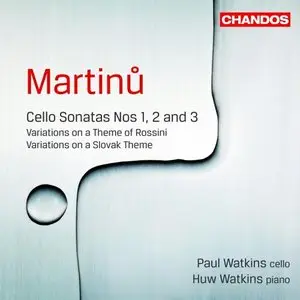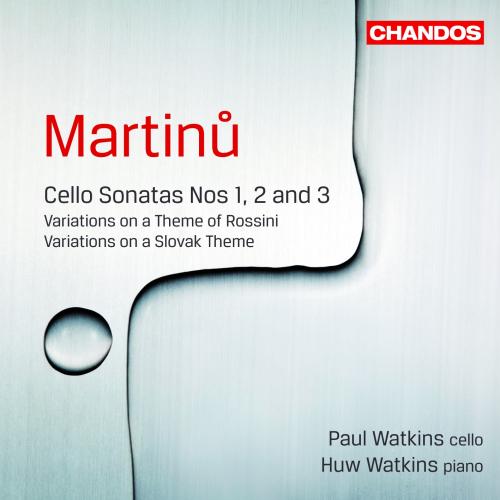Paul Watkins, Huw Watkins - Martinu: Cello Sonatas Nos. 1, 2 & 3 (2010)
EAC Rip | Flac (Image + cue + log) | 271 MB | MP3 320Kbps CBR | 167 MB | 1 CD | Full Scans
Genre: Classical | Label: Chandos | Catalog Number: 10602
EAC Rip | Flac (Image + cue + log) | 271 MB | MP3 320Kbps CBR | 167 MB | 1 CD | Full Scans
Genre: Classical | Label: Chandos | Catalog Number: 10602
Paul Watkins is one of the world’s finest cellists. He is much in demand throughout the world and although he has made several recordings for Chandos in the past, this is his first as an exclusive artist. He is accompanied by his brother Huw Watkins, with whom he has developed an extremely rewarding musical partnership. The three cello sonatas of the Czech composer Bohuslav Martinu span the period 1939 – 52 and are full of rewarding musical invention. The experience of his long exile was often expressed in his music, particularly here in the Third Sonata and in the Variations on a Slovak Theme. If in the First, competed in 1939, the unease occasioned by World War II may be detected in the first two movements, the energetic finale, driven by Martinu’s motoric rhythms, prompted the composer to remark of its first performance: ‘It came as a last greeting, a beam of light from a better world (which is the opinion of others, not my own). For several minutes we realised what music could give us and we forgot about reality.’
In the Second Sonata, of 1941, the composer embraced classical forms, though the first movement is typically vigorous and energetic, in the composer’s most rhythmic manner. The second movement is full of passionate longing, with a gorgeous lyrical cello line, whilst the finale uses the composer’s characteristic motor rhythms, with powerful stamping gestures suggesting Bohemian peasant dances.
The Third Sonata, completed in October 1952, is the most immediately appealing of the three sonatas, full of attractive Czech melodies and offering essentially good-natured melodies and harmony – as well as humour, especially in the finale.
The Variations on a Theme of Rossini (1942), dedicated to Gregor Piatigorsky, shows the composer at his most wittily light-hearted, and offers brilliance and virtuosity in spades. The Variations on a Slovak Theme (1959) were written during the composer’s final illness – Martinu had been diagnosed with stomach cancer. They are certainly appealing and resourceful, but strong feelings for the distant homeland are distinctly audible.
Composer: Bohuslav Martinu
Performer: Huw Watkins, Paul Watkins
Reviews: This generously filled CD is a complete success. Most recordings of Martin?’s cello sonatas contain only the three sonatas; here we have the added bonus of his two delightful sets of variations. I find all five compositions rewarding in every way: rhythmically, melodically, emotionally, in their formal structure, and as exemplary writing for the two instruments. The music is not unknown, but hasn’t yet been taken up by the world’s most famous cellists and is still underappreciated. The performances are superb. I particularly admire Paul Watkins’s unforced cello sound, the fluency and shapeliness of Huw Watkins’s piano playing, and the give and take of their ensemble.
The charge of facile note spinning sometimes justifiably leveled at Martin? doesn’t apply to the three cello sonatas, which are among his best, most communicative chamber works. Each comes from a different stage of his exile from Czechoslavakia. The first was premiered by Pierre Fournier and Rudolf Firkušný in Paris in 1939 and is the most angular sounding, severe at times, with neobaroque underpinnings, and a fiery finale. (Firkušný’s recording of the three sonatas with János Starker is a good one, though Paul Watkins achieves more variety of sound than Starker.) The second was written in 1941 in New York and is a successful attempt at composing in a more accessible style. Its strength and rhythmic irregularities are similar to the first sonata’s but its textures are less busy and the slow movement speaks simply and powerfully. The third sonata, from late in Martin?’s life, is a sparkling, joyous work suffused with a nostalgic, Czech flavor.
The Variations on a Theme of Rossini (it’s the prayer “Dal tuo stellato soglio” from Mosé in Egitto ) is an amusing display piece from 1942, dedicated to Gregor Piatigorsky and ingeniously scored for the two instruments. Martin? was terminally ill when he composed the Variations on a Slovak Theme, in Switzerland in 1959 at the home of Paul Sacher. It’s based on a rhapsodic folk tune and the variations proceed in an urgent, continuous manner.
I compared the Watkins’s recording to a 1988 Hyperion CD of the three sonatas by cellist Steven Isserlis and pianist Peter Evans. Isserlis and Evans are given a more reverberant acoustic and seem to be closer-miked. In their recording, one hears Martin?’s dynamic markings faithfully but too literally reproduced. For example, if the score has both instruments marked mezzo forte, that is what is heard. The problem is that the goal, in any chamber music, should be a blend of instrumental volume levels that creates an overall balance that will register as mezzo forte but which might involve the piano part being played much more quietly than indicated. Happily, Chandos’s engineers understand this and the less reverberant, more spacious sound provided for the Watkins brothers allows the music to breathe and nuances of each instrumental line to come across. Motoric passages achieve a real sense of motion, unimpeded by accents or accumulated boominess, and the Watkins bring more of the needed bounce to Martin?’s trademark syncopations than Isserlis and Evans.
Tracklisting:
[1]-[3] Sonata No.1, H 277 (1939)
for Cello and Piano
À Pierre Fournier
[4] Variations on a Slovak Theme, H 378 (1959)
for Cello and Piano
[5]-[7] Sonata No.2, H 286 (1941)
for Cello and Piano
To Frank Rybka
[8] Variations on a Theme of Rossini, H 290 (1942) in D major
for Cello and Piano
To Gregor Piatigorsky
[9]-[11] Sonata No.3, H 340 (1952) in C Major
for Cello and Piano
In memory of Hans Kindler
Exact Audio Copy V0.99 prebeta 5 from 4. May 2009
EAC extraction logfile from 1. November 2011, 2:11
Paul Watkins, Huw Watkins / Martinu - Cello Sonatas Nos1,2,3
Used drive : HL-DT-STDVDRAM GSA-4083N Adapter: 1 ID: 0
Read mode : Secure
Utilize accurate stream : Yes
Defeat audio cache : Yes
Make use of C2 pointers : No
Read offset correction : 667
Overread into Lead-In and Lead-Out : No
Fill up missing offset samples with silence : Yes
Delete leading and trailing silent blocks : No
Null samples used in CRC calculations : No
Used interface : Native Win32 interface for Win NT & 2000
Used output format : User Defined Encoder
Selected bitrate : 768 kBit/s
Quality : High
Add ID3 tag : No
Command line compressor : C:\Program Files\Exact Audio Copy\FLAC\FLAC.EXE
Additional command line options : -6 -V -T "ARTIST=%a" -T "TITLE=%t" -T "ALBUM=%g" -T "DATE=%y" -T "TRACKNUMBER=%n" -T "GENRE=%m" -T "COMMENT=%e" %s -o %d
TOC of the extracted CD
Track | Start | Length | Start sector | End sector
––––––––––––––––––––––––––––-
1 | 0:00.00 | 5:42.50 | 0 | 25699
2 | 5:42.50 | 5:50.32 | 25700 | 51981
3 | 11:33.07 | 5:28.32 | 51982 | 76613
4 | 17:01.39 | 9:05.51 | 76614 | 117539
5 | 26:07.15 | 6:38.49 | 117540 | 147438
6 | 32:45.64 | 7:02.52 | 147439 | 179140
7 | 39:48.41 | 4:55.32 | 179141 | 201297
8 | 44:43.73 | 7:40.05 | 201298 | 235802
9 | 52:24.03 | 7:07.01 | 235803 | 267828
10 | 59:31.04 | 5:23.57 | 267829 | 292110
11 | 64:54.61 | 5:22.06 | 292111 | 316266
Range status and errors
Selected range
Filename J:\Music\Bach - The Complete Organ Music - Herrick\Martinu - Cello Sonatas Nos1,2,3.wav
Peak level 84.4 %
Range quality 99.9 %
Copy CRC F6134068
Copy OK
No errors occurred
End of status report
EAC extraction logfile from 1. November 2011, 2:11
Paul Watkins, Huw Watkins / Martinu - Cello Sonatas Nos1,2,3
Used drive : HL-DT-STDVDRAM GSA-4083N Adapter: 1 ID: 0
Read mode : Secure
Utilize accurate stream : Yes
Defeat audio cache : Yes
Make use of C2 pointers : No
Read offset correction : 667
Overread into Lead-In and Lead-Out : No
Fill up missing offset samples with silence : Yes
Delete leading and trailing silent blocks : No
Null samples used in CRC calculations : No
Used interface : Native Win32 interface for Win NT & 2000
Used output format : User Defined Encoder
Selected bitrate : 768 kBit/s
Quality : High
Add ID3 tag : No
Command line compressor : C:\Program Files\Exact Audio Copy\FLAC\FLAC.EXE
Additional command line options : -6 -V -T "ARTIST=%a" -T "TITLE=%t" -T "ALBUM=%g" -T "DATE=%y" -T "TRACKNUMBER=%n" -T "GENRE=%m" -T "COMMENT=%e" %s -o %d
TOC of the extracted CD
Track | Start | Length | Start sector | End sector
––––––––––––––––––––––––––––-
1 | 0:00.00 | 5:42.50 | 0 | 25699
2 | 5:42.50 | 5:50.32 | 25700 | 51981
3 | 11:33.07 | 5:28.32 | 51982 | 76613
4 | 17:01.39 | 9:05.51 | 76614 | 117539
5 | 26:07.15 | 6:38.49 | 117540 | 147438
6 | 32:45.64 | 7:02.52 | 147439 | 179140
7 | 39:48.41 | 4:55.32 | 179141 | 201297
8 | 44:43.73 | 7:40.05 | 201298 | 235802
9 | 52:24.03 | 7:07.01 | 235803 | 267828
10 | 59:31.04 | 5:23.57 | 267829 | 292110
11 | 64:54.61 | 5:22.06 | 292111 | 316266
Range status and errors
Selected range
Filename J:\Music\Bach - The Complete Organ Music - Herrick\Martinu - Cello Sonatas Nos1,2,3.wav
Peak level 84.4 %
Range quality 99.9 %
Copy CRC F6134068
Copy OK
No errors occurred
End of status report
Thanks to the original releaser



